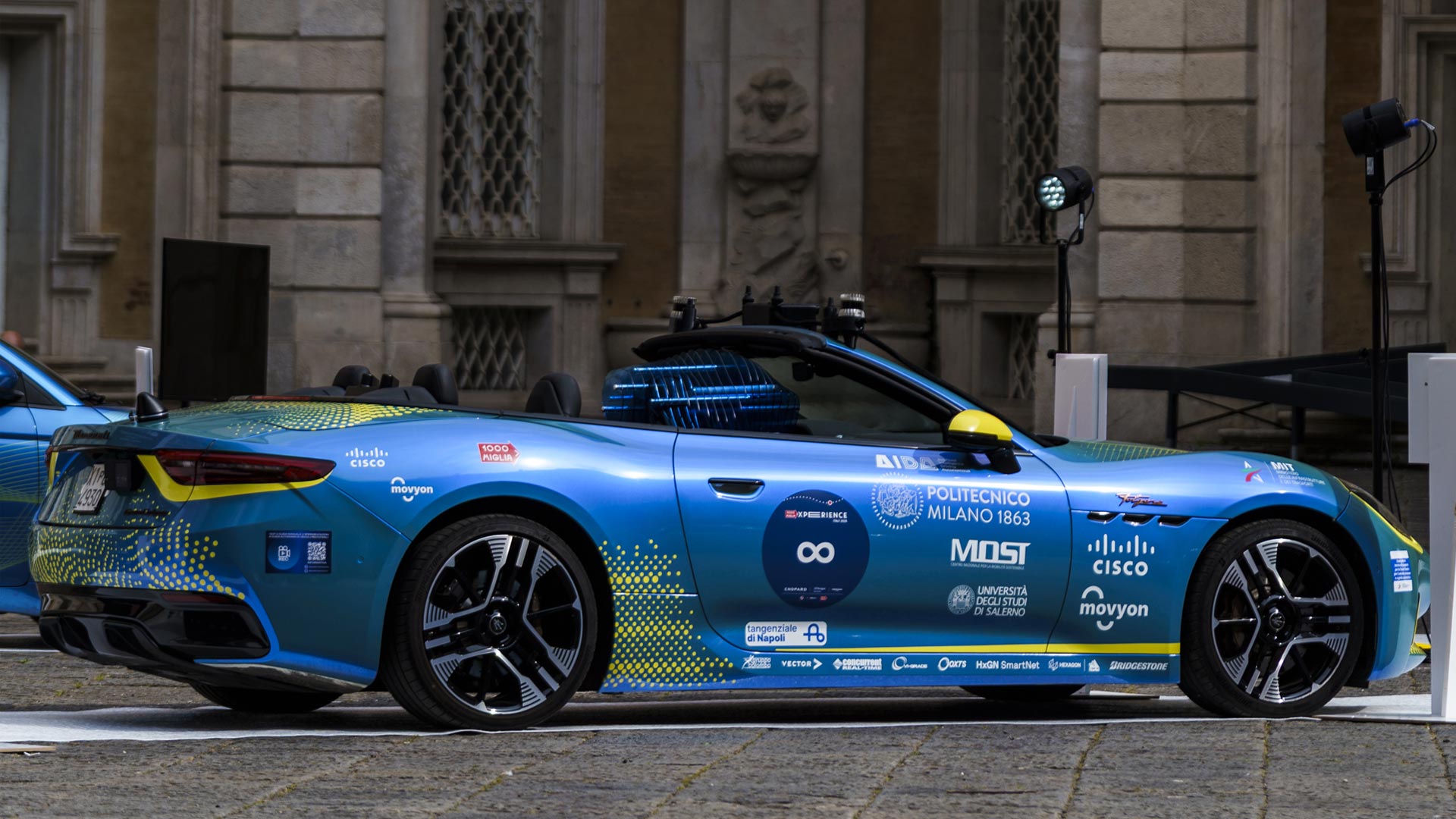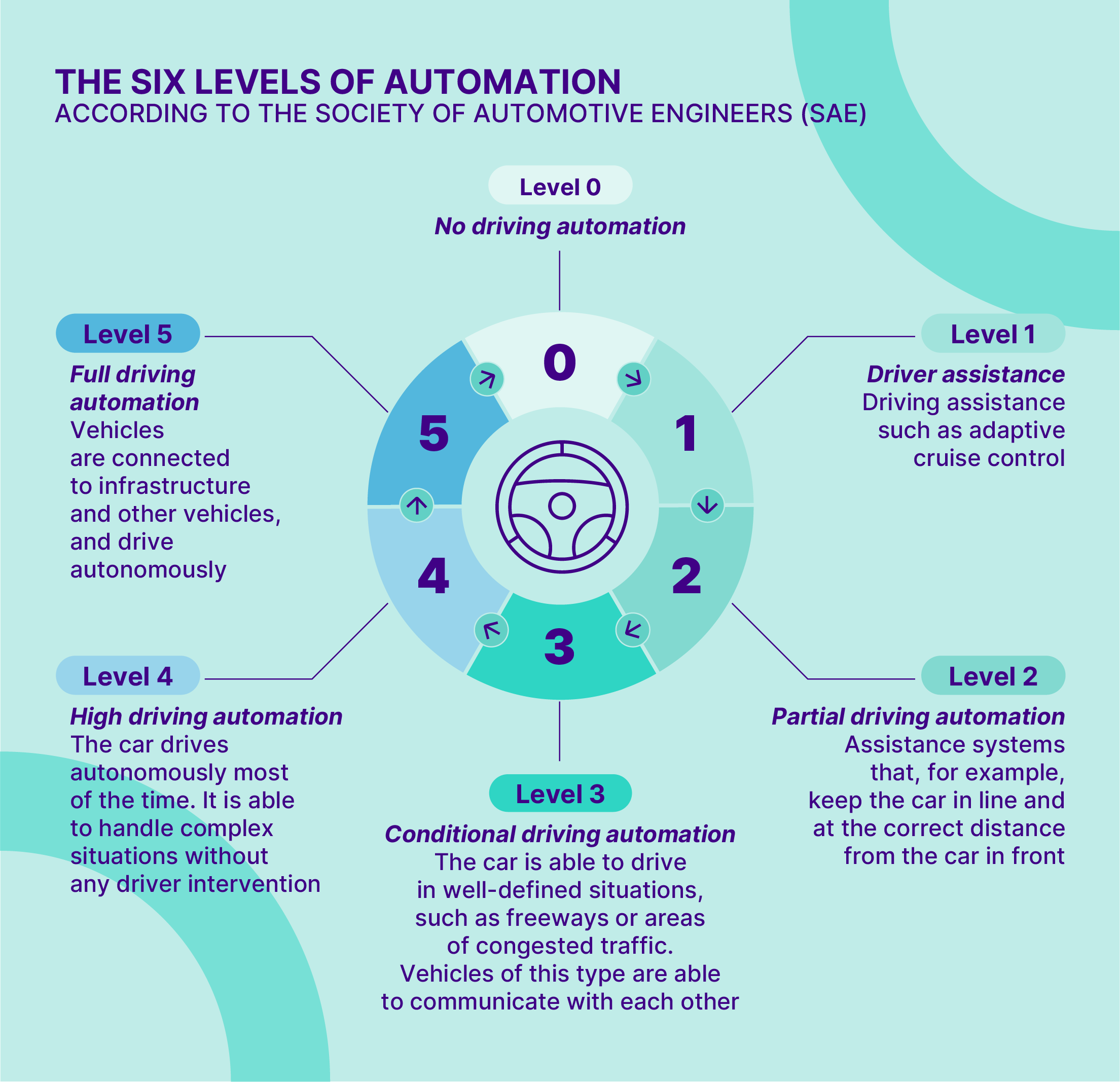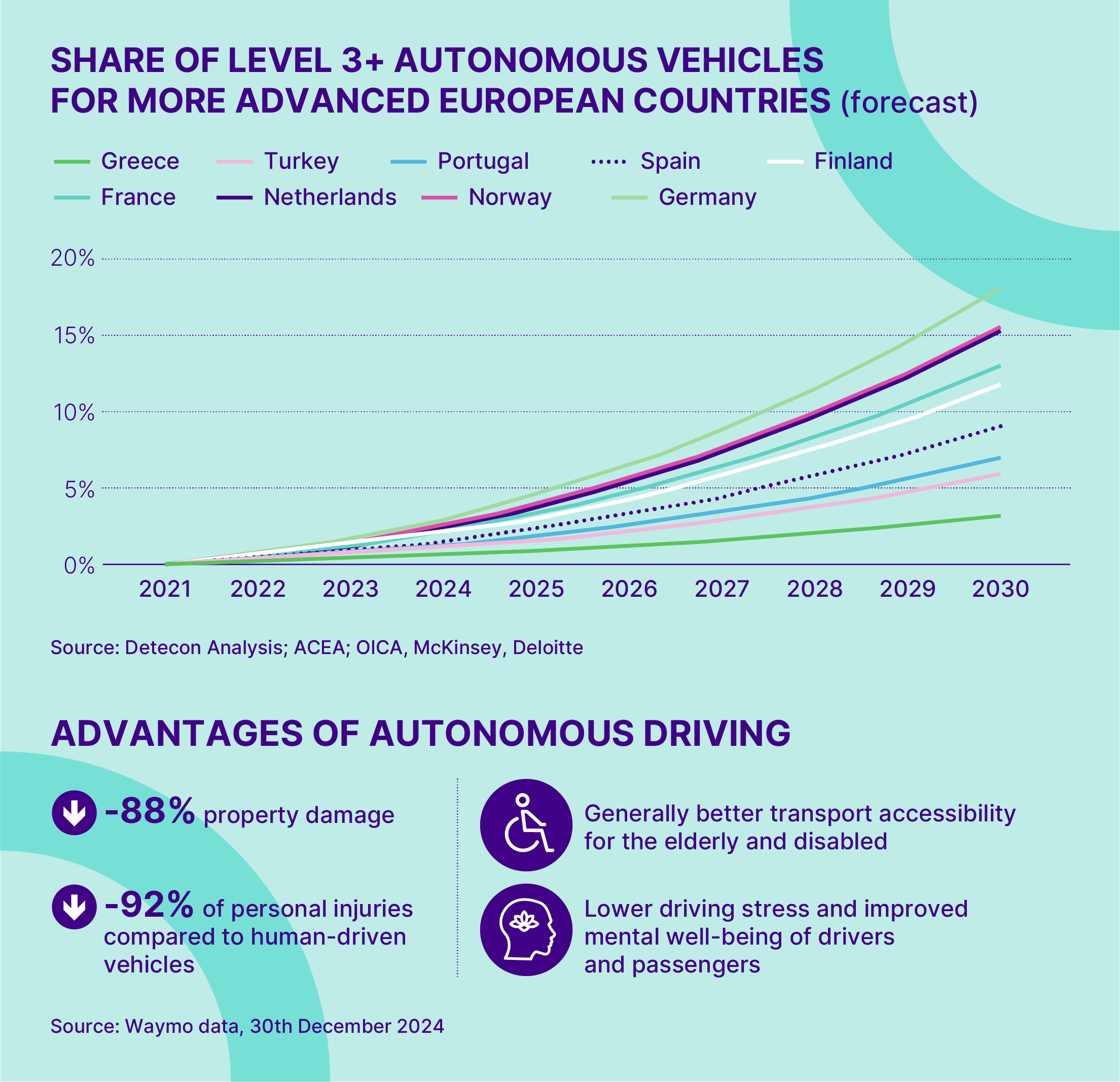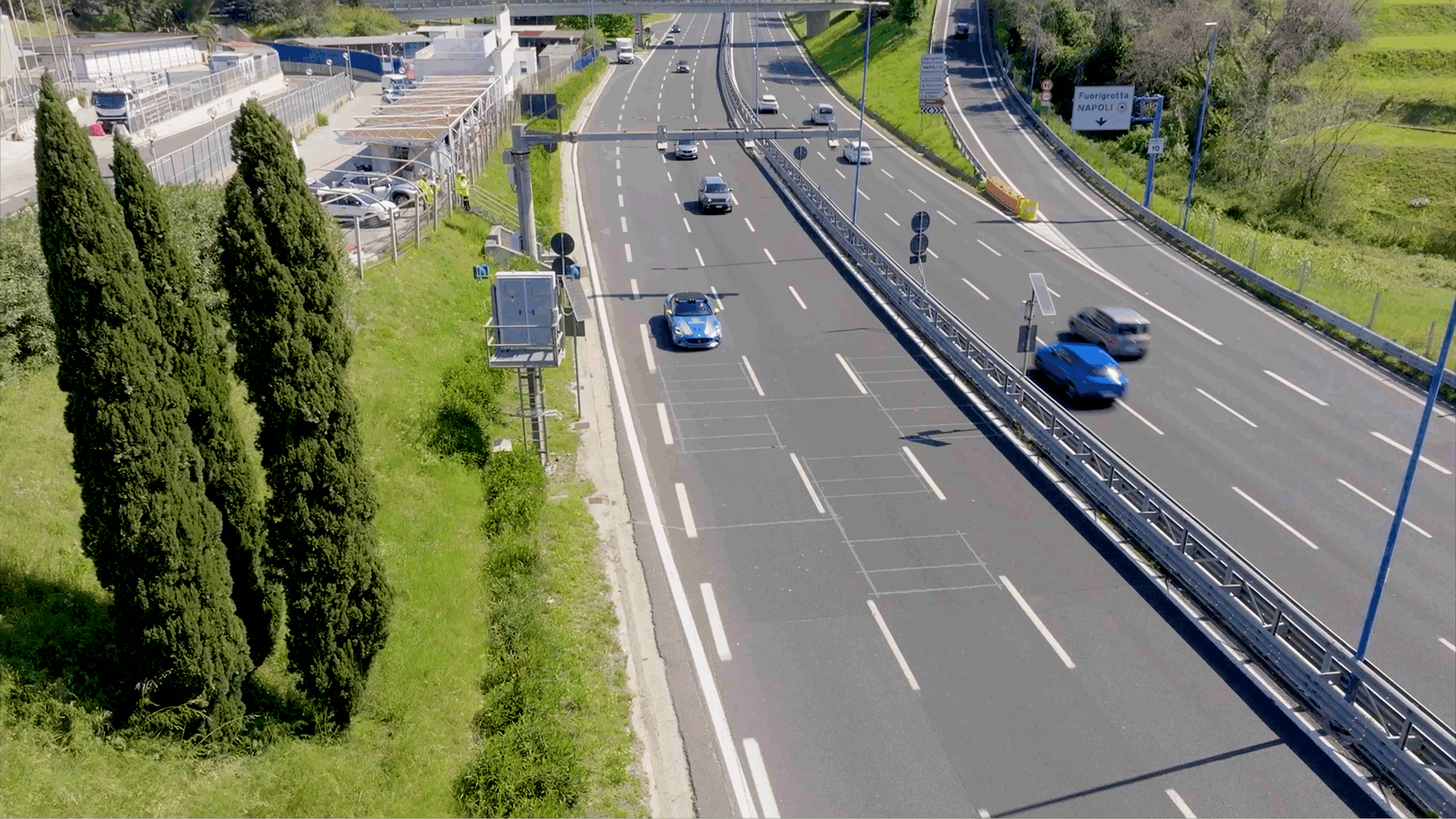
TREND > SMART MOBILITY
Autonomous driving reshapes the future of mobility
Cars that can move without the intervention of drivers, roads and freeways that interact with vehicles: it is not science fiction, but increasingly closer to reality, destined to make road driving much safer.
Autonomous vehicles promise to revolutionize our movements. Innovative technologies – based on interconnecting automated driving systems, sensors and smart infrastructure – could allow vehicles to move around without any driver intervention in the not-too-distant future.
Tests on autonomous vehicles are increasingly frequent in Europe. Countries and organizations are developing programs to trial autonomous driving on public roads. To ensure maximum safety and avoid committing regulatory offenses, these tests are often conducted under human supervision and in “safe” environments. The European Union is working to harmonize these test procedures among Member States.
The six levels of automation
To what extent is a vehicle able to perform the driver’s tasks, and how can humans and machines interact on the road? To answer these questions, the Society of Automotive Engineers (SAE) has divided automation into 6 steps ranging from level 0, no driving automation, to level 5, full driving automation.

The regulatory situation
The majority of vehicles on the current market operate with automation level 2, which includes automatic intervention in particular situations, such as braking in the event of danger. Several companies are working on level 3, where automation partially replaces drivers, but still requires their participation. Level 3, however, has only been authorized in certain countries and within specific scenarios.
Specifically, the European Union States have approved Article 34 bis of the Vienna Convention (of 14/07/2022), which allows autonomous vehicles to drive on roads. In Europe, France and Germany have already introduced comprehensive legislation on the adoption of such vehicles, while according to the Autonomous Vehicles Readiness Index, the Netherlands and Norway are among the nations most ready for autonomous driving. In the rest of the world, the United States, South Korea and New Zealand are at the forefront of the sector.
Adapting the rules is an essential step to promote a sector that, according to “Markets and Markets”, is currently worth 12.4 billion dollars worldwide, a value that will reach 26.4 million by 2030, with an annual growth rate of 13.3%.
Obstacles along the way
The path to full vehicle automation is paved with unknowns. Public roads are complex, dynamic environments, and they were not designed for autonomous driving. Moreover, vehicles equipped with automation constantly need to know where they are, currently via GPS signal. In fact, if an autonomous vehicle encounters a situation that is not among the foreseen scenarios, the driver must intervene and take control.
Regarding infrastructure adaptation, it should be noted that vehicle manufacturers have not yet made clear decisions about the preferred communication technologies. The 5G network is seen as critical to improving vehicle-infrastructure communication performance, but it is not ready for deployment as it is still under development. So, the infrastructure generally has some difficulty in offering widespread services with high performance levels. In addition, there are obstacles of a regulatory nature, together with the issues of responsibility and ethics.
The advantages of autonomous driving
Despite the obstacles standing in the way of achieving the highest levels of autonomous driving, it is worth continuing trials, with the aim of ensuring that autonomous driving develops to guarantee adequate safety levels, and improve traffic flow and environmental sustainability.
In fact, it is necessary to consider that most accidents are caused by driver misconduct. Autonomous driving should eliminate distractions and erroneous actions, leading to a large reduction in accidents. Its development is therefore important, because it could lead to a decisive change in the world of mobility.


A not-too-distant future
Autonomous driving is not far off or futuristic, but is close to becoming reality. Carmakers are conducting important research and trials in this area, while – on the infrastructure side – leading companies operating in the roads and freeways sector are implementing technologies intended to make communication “on the move” increasingly refined and effective.
Worldwide competition is tight. In Phoenix, San Francisco and Los Angeles in the USA, driverless robotaxis are already operational, using a sensor system that combines radar, cameras and LIDAR technology. The latter measures the distance of an object by illuminating it with laser light, and returning high-resolution three-dimensional information about the surrounding environment. Integrating sensors guarantees a three-dimensional view of the environment, even in low visibility conditions. Tesla has chosen an approach based on cameras and neural networks designed to analyze the road and any obstacles, while General Motors is investing massively in autonomous driving with Cruise, which combines LIDAR, radar and cameras to ensure high reliability in complex urban environments.
The final objective is to develop cooperative technologies (C-ITS systems) in order to promote the activities of freeway operators so that the infrastructure can increase the ability of vehicles to safely maintain their driving automation levels, and thus contribute to the development of autonomous driving in a sustainable way.
How? By exploiting devices along the freeway, which communicate with each other and with traffic control centers: in this way, vehicles can receive useful information (roadworks, queues, accidents) and infrastructures are able to collect traffic data.
A further step towards autonomous driving could also come from exploiting devices located throughout the network to improve precise positioning where the GPS signal is unavailable or weak. It would also be essential to study how the vehicle “reads” the road – for example, horizontal and vertical signage – to understand what technologies or measures need to be introduced to ensure that the road infrastructure is ready to safely accommodate autonomous driving.

Successful Projects
Here you can take a look at a selection of our most significant projects and find out how we have helped meet our customers’ needs innovatively and efficiently.